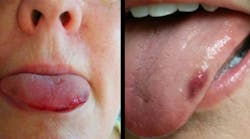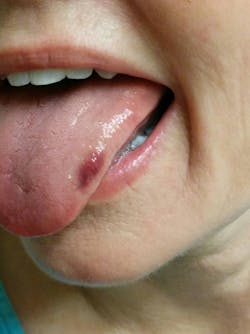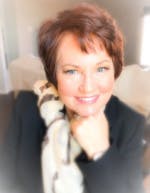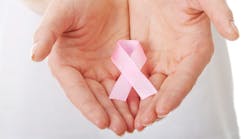Nocturnal epileptic seizures and their oral complications
Figure 1: Bruising of the lateral border of the tongue due to a seizure
Abstract
Epilepsy is a neurological condition occurring in the brain. If a person has had two or more seizures, they are considered to have epilepsy. When a person experiences a seizure, the body will flex and extend, and the person may lose consciousness. A person may also inflict damage to the oral cavity. The person may bite the tongue, lips, and cheeks. Teeth may be fractured, periodontal ligaments damaged, and the temporomandibular joint traumatized. Nocturnal epileptic seizures occur during sleep and may be experienced unknowingly. Dental professionals can assist patients who are unknowingly experiencing nocturnal epileptic seizures, as well as patients who are experiencing the negative oral side effects of anticonvulsant medications.
Seizures and epilepsy
The brain sends messages to all parts of the body through electrical activity via nerve cells. (7) A seizure can occur when the brain receives abnormal electrical signals that interrupt normal neurological activity. (3,5,6) When a person experiences two or more seizures, they are considered to be epileptic. (1–6,10) Epilepsy can affect people of any age, gender, or race. (1,8,9)
There are two main categories of seizures: focal seizures and generalized seizures. Generalized seizures occur in the cerebral cortex of the brain. Focal seizures, which are also called partial seizures, take place in one or more areas and on one side of the brain. (1,4) Within these two categories are many subtypes.
Any type of seizure can occur during sleep. (5,6,8) However, some types of seizures are restricted to sleep. These are referred to as nocturnal epileptic seizures. (11) Nocturnal epileptic seizures fall under the generalized seizures category. (2,3,5)
Incidence and prevalence
The incidence of epilepsy in the US is estimated to be 48 out of 100,000 people. (2,9) The prevalence is estimated to be 2.2 million people, or 8.4 out of 1,000 people. (2,12) Approximately 8% to 10% of the population will experience a seizure, but only 2% to 3% will develop epilepsy. (9,12,13)
Symptoms
When a person is experiencing a seizure, the body will flex or contract. Then, the body will then extend and straighten out. This can happen repeatedly. A person may have involuntary jerking of the arms and legs, flexing and contracting of the arms and legs, and loss of bladder control. (2, 13) A person may vomit, which can be serious due to risk of aspiration. A person may or may not experience loss of consciousness.
Some people experience an aura before having a seizure. (2) Others may have a prickling sensation and tingling in their legs. (15) Some people report that they feel like they are in a tunnel and sounds can be exaggerated and disturbing. A person may report feeling foggy. A person also may feel weak or as if he or she were on an elevator and falling.
After a seizure, a person may have memory loss, act sleepy, have blurred vision, have difficulty speaking, and experience muscle fatigue or body aches. The physical experience of having a seizure has been compared to running a marathon. (2,16)
Etiology
Epilepsy is a disorder of the central nervous system and potentially abnormal neuron wiring. (13,17) Causes of seizures include illness, stress, high fever, improper brain development, dehydration, birth injury, head injury, drug withdrawal, and stroke. (4,17,18) Febrile seizures in children can occur with a temperature greater than 101 degrees Fahrenheit. (13) Brain injuries, such as a concussion with a rapid acceleration and deceleration of the brain, can cause disruption of brain functions. (18) Sleep deprivation has been documented to trigger seizures. (3) Some seizures are idiopathic. (9)
Aspartame (α-aspartyl-l-phenylalanine-o-methyl ester), which is used as an artificial sweetener, has been linked to seizures and other neurophysiological problems. (19,20) Aspartame breaks down into phenylalanine, which transmits impulses in the brain. It also breaks down into aspartic acid, an essential amino acid, and methanol. (19) A further breakdown product is formaldehyde (21,22). Aspartame's raising of phenylalanine levels increases the threat of seizures. (19,24) NutraSweet is the brand name for aspartame, which has Food and Drug Administration approval and its Generally Recognized As Safe designation. (15,20,21) Whole Foods lists aspartame as an unacceptable sweetener. (12,19,21,22)
Diagnosis
There are several ways to identify if a patient has experienced a seizure. Doctors evaluate several factors to determine the type of seizures a patient has experienced. (5,18) Factors include age, when the seizure began, family history, and other medical conditions, such as a history of a stroke or brain injury. (18) A neurologist can order an electroencephalogram to measure brain activity, a CT scan, or magnetic resonance imaging to look at all of the structures in the skull and identify abnormalities. (3,7,23,24)
Pharmacological treatment
There are many anticonvulsant drugs available on the market. Seizures can be treated with medications such as phenobarbital. Divalproex sodium (Depakote), valproic acid (Depakote), and topiramate (Topamax) may also be used. (2,5,16,18,19,25,26) Side effects from some of these medications can include damage to the liver or pancreas, impaired platelet aggregation, hair loss, weight gain, indigestion, diarrhea, and nausea. Cannabidiol has been used to treat resistant seizures. (25,26,27)
In the oral cavity, medications used to treat and maintain control of seizures can cause gingival hypertrophy, xerostomia, and oral yeast infections. (11,28) Antiepileptic drugs have been associated with congenital malformations, which include cleft lip, club foot, and cardiac malformations, just to name a few. (25,26) Newer drugs are available for pregnant women, such as Lamotrigine and Levetiracetam. However, it should be noted there remain risks of congenital malformations with any of the anticonvulsant drugs. (25,26)
Prognosis
The National Institutes of Health, Centers for Disease Control, Food and Drug Administration, and Interagency Collaborative to Advance Research in Epilepsy each support research to better understand and treat epilepsy. (24) Epilepsy does not currently have a cure. Seizures, however, can be controlled with medications, diet, electrical devices (1,2,29), or surgery. (13) It is reported that most seizures do not cause brain damage, but multiple prolonged seizures can cause extensive damage. (27) Epilepsy can be life threatening if not treated or controlled. (20)
Epilepsy can also cause a patient to become embarrassed. A person may develop emotional or social concerns pertaining to the condition. (17)
A study in Australia reported that in sudden unexpected death in epilepsy, or SUDEP, 90% of the individuals were at home. Seventy percent of the deaths occurred overnight, and seizures were a key factor. (8,23) Some recreational activities, such as snow skiing and swimming, may be restricted for persons who experience seizures. (30) Some states do not issue driver’s licenses to individuals with epilepsy.
How seizures affect the oral cavity
During a seizure, a person may bite the tongue, lips, and cheeks. (15) They may have possible fracturing or breaking of teeth. (15) The temporomandibular joint can be affected, as well as damage to the periodontal ligaments of the dentition. Bruising of the lateral border of the tongue is apparent in Figure 1 (above). The person was wearing upper and lower custom mouth guards.
Bruising, hematomas, and petechia may be evident after a seizure. Bite marks and hematomas are exhibited in Figure 2. This damage is from the person biting or locking down on her tongue during a seizure. The tongue may even require suturing if severely damaged.
Figure 2: Bite marks and hematomas on the tongue due to seizure
Dental considerations and treatment
It is extremely important that a dental patient taking anticonvulsant drugs maintain immaculate oral hygiene with proper brushing and flossing. Frequent recall appointments are needed to maintain proper biofilm removal and reduce the risk of developing gingival hyperplasia. (17)
During periodontal procedures, a person taking valproate may have increased bleeding. (11,17,28) It is recommended that the person have blood levels checked before beginning periodontal treatment. (15) There are no contraindications with epinephrine with persons taking Depakene. (18)
A person taking anticonvulsant drugs may experience xerostomia. (11) Oral moisturizing rinses can be recommended.
Mouth guards can be helpful to prevent a person from severely biting the tongue, lips, and cheeks.
My seizures
After experiencing a seizure, I was taken to the hospital, checked over, and sent home. The next night I had a second seizure. An ambulance again was called. I went back to the hospital for testing. I was diagnosed with nocturnal epileptic seizures with generalized tonic-clonic seizures. I was prescribed anticonvulsant medication and sent home.
The following month was a blur. I was not cognizant of many things that had occurred. My memory was not good. During my seizures, I had severely bit my tongue. Thank goodness I was wearing my upper and lower mouth guards. It could have been much worse.
I experienced strange aftereffects. I could look at a cup, know what the object was, but be unable to verbalize that it was a cup. I recognized friends but could not remember their names. I was unable to drive for a period of time. When I started driving again, I was nervous that I might have another seizure, which increased anxiety levels. I would sit in church and worry that I might experience another seizure.
Several years passed, and I felt better and my memory was coming around. But four years ago I started having strange symptoms. I felt like I had an aura around me, needles sticking into my calves, dizziness, nausea, a feeling that I was in a tunnel, and exaggerated hearing. I felt as if I was on an elevator and falling. I felt weak and as if my body was vibrating. I felt like I was out of my body.
I thought I was just very tired, but that was not it. During the night I had experienced another seizure.
"Here I go again. Back in the hospital," I thought. My medication was doubled.
I have had a few more minor seizures, but I now can recognize when I might experience another seizure. Life is good.
On Christmas Eve of 2017, my bother-in-law called me in the wee hours of the morning. It turned out that my sister was having the same type of seizures I experienced. My sister is three years older. Why did we both having seizures this late in our lives? One difference between us is that she experiences migraine headaches and has sarcoidosis. (10) We eat healthy, do not smoke, exercise, and drink lots of water, so it is puzzling to our doctors and to us that we would develop the exact type of nocturnal epileptic seizures. We asked our neurologists if our seizures are hereditary. The answer we received was "no." (16)
Summary
Epilepsy is a neurological condition involving the brain. A seizure occurs when the brain receives abnormal electrical signals that can interrupt normal electrical brain activity. There are many documented triggers for a seizure, such as disease, stroke, trauma, family history, and diet. Epilepsy cannot be cured, but seizures can be controlled and treated with proper medication, diet, surgery, and electronic devices.
If a dental patient presents to your office with unexplained bite marks of the lips, tongue, or cheeks, think outside the box. Has this patient experienced a seizure?
Related:Gabapentin: The most dangerous drug in America?
References
1. American Academy of Neurology 2013. Vagus nerve stimulation for treating epilepsy. www.aan.com
2. Epilepsy 02/11/16. www.google.com/search?q Choudhary, A. K.; Lee, Y. Y., Neurophysiological symptoms and aspartame: What is the connection? Nutritional Neuroscience 2018. VOL 21. NO. 5.
3. Epilepsy/understanding-epilepsy/nocturnal-seizures-during sleep. 05/25/2018. https://www.epilepsy.org.au/about
4. French, Jacqueline A. Febrile seizures: Possible outcomes. Neurology 2012; 79; e80-82.
5. Morris, Susan, York. Identifying and treating nocturnal seizures. Medical review 12/26/14.
6. Neurological technology of New York. Columbia University, 2015. Epilepsy and Seizures.
7. EEG How a test is performed. MedlinePlus Medical Encyclopedia. 2016. https://www.nlm.nih.gov/medlineplus/ency/article/003931.htm 06/29/16
8. Clark D., Riney K. A population-based post mortem study of sudden unexpected death in epilepsy. DOI: 10.16/j.jocn.2015.04.027.
9. Epilepsy.com. Epilepsy statistics. Epilepsy foundation. 03/19/14. https://www.epilepsy.com/learn/about-epilepsy-basics/epilepsy-statistics
10. Exinor, Ivianie, RDH, MPH, Management of the Patient with Sarcoidosis. Access. March, 2016.
11. Stoopler, E.T.,et al. Seizure disorders: update of medical and dental considerations. General Dentistry 2003,51 (4):361;quiz 367.
12. Tao, James, X.,; Davis, Andrew M. Management of an unprovoked first seizure in adults. JAMA 10/18/16. VOL. 316. NO. 15.
13. Gavvala Jay R., Schuele, Stephen U., New-Onset Seizure in Adults and Adolescents A Review.
14. “Le grand mal intellectual” by Jules Falret, (1861), the first complete description of postictal psychosis. Translated by Mrs. Jane Lee Elsevier B.V. 2016.
15. Stegeman, C. and Davis, J. The Dental Hygienist’s Guide to Nutritional Care. (4th ed.) St. Louis, Mo.: Elsevier, Inc. (2015).
16. Dr. Todd A. Maraist, M.D. Neurologist. Personal interview Oct. 2018.
17. Diseases and Disorders, 2nd edt. Lippincott Williams &Wilkins. 2005
18. Riggio, S, Jagoda, A. Concussion and its neurobehavioral sequelae. International Review of Psychiatry, 2016. VOL. 28. No. 6. 579-586.
19. Choudhary, A. K.; Lee, Y. Y., Neurophysiological symptoms and aspartame: What is the connection? Nutritional Neuroscience 2018. VOL 21. NO. 5.
20. Kairos, Tiffany. The Epilepsy Journey, Foods containing aspartame linked to seizures. Epilepsy network. http://tiffanykairos.com/foods-contain-aspartme-linked-to-seizures/ 5/29/2018.
21. The Consumers’ Medical Journal. 01647202. Aspartame (Nutraswee™): Is it Safe?
22. Tufts University. Health and Nutrition Letter. FDA Rejects Aspartame –Ban Petitions. www.nutrtionletter.tufts.edu.
23. Song, M.X., Deng, X.Q. Recent developments on triazole nucleus in anticonvulsant compounds: a review. Journal of Enzyme Inhibition and Medicinal Chemistry. 33:1,453-478. DOI: 10.1080/14756366. 2017.
24. National Institute of Neurological Disorders and Stroke. Seizure disorders. 03/16/18 http://www.ninds.nih.gov/disorders/epilepsy/epilepsy.htm#Publications.
25. Veroniki et al. Comparative safety of anti-epileptic drugs during pregnancy: a systematic review and network of congenital malformations and prenatal outcomes. BMC Medicine (2017) 15:95 DOI 10.1186/s12916-017-0845-1
26. Weinberg MA, et al. Oral pharmacology for the dental hygienist 2nd edt. 2013.
27. Devinsky O. et al. Effect of Cannabidiol on drop seizures in the Lennox-Gastaut Syndrome. N ENG J MED378; 20 NEJM.ORG 05/17/18.
28. Daniels, W.W., DMD, MS. Personal Interview. June 2018.
29. Curing the Epilepsies: The Promise of Research: National Institute of Neurological Disorders. http://www.ninds.nih.gov/disorders/epilipsy/epilepsy_research.htm. 2016.
30. Mayo Clinic Staff. Epilepsy. 06/29/16. http://www.mayoclinic.org/diseaes-conditions/epilepsy/home/ovc-20117206?p+1





